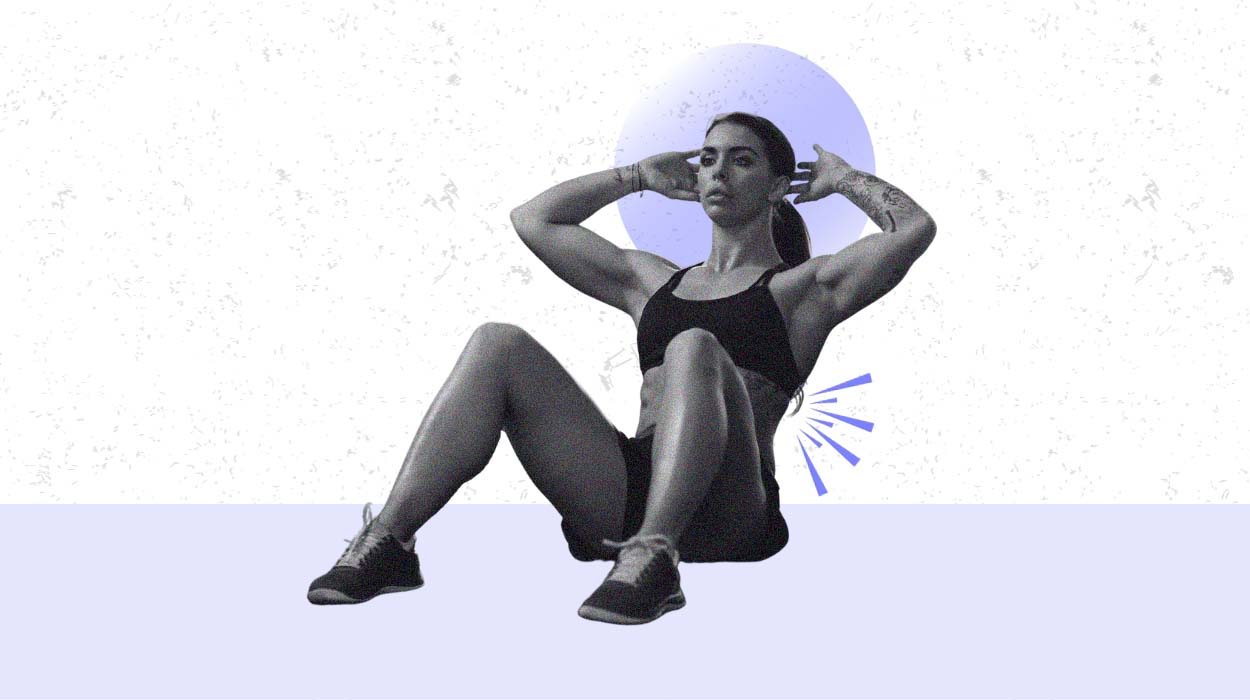
For those with lower back pain, the mere thought of an ab workout can be dreadful. You may even wonder if you can do ab workouts with lower back pain. The good news is you can.
A strong core is crucial for overall stability, posture, and alleviating lower back discomfort. So let’s explore ten Ab workouts for bad backs that prioritize core strength while minimizing stress on the lower back. And by adding these exercises with a great fat burner, you may just get the toned, sculpted abs of your dreams.
10 Best Ab Exercises For Lower Back Pain
Here are ten ab workouts with lower back pain you can do:
Ab Workouts With Lower Back Pain To Try
These ten ab workouts for lower back pain can help strengthen your core, which may help with lower back pain:
Sit-Ups
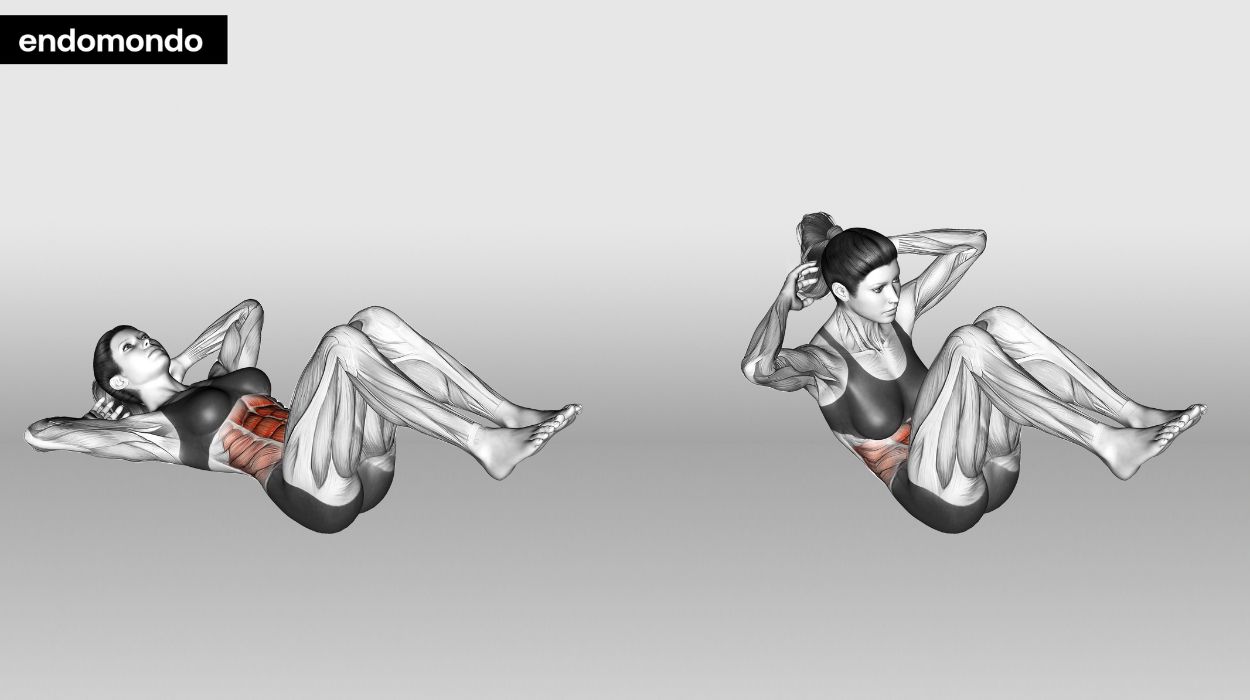
You can perform sit-ups with your knees bent or use an exercise ball for added support to reduce strain on the lower back.
How to do:
- Lie on your back or an exercise ball.
- Keep your feet flat on the floor and your knees bent.
- Place your hands behind your head, elbows out to the sides.
- Use your core and lift your upper body off the floor, curling towards your knees.
- Exhale as you come up and inhale as you lower back down.
- Avoid pulling on your neck by using your abdominal muscles to initiate this movement.
Tips:
- Place a rolled towel or cushion under your lower back to provide extra support and reduce the strain on your lower back.
- Perform the exercise with a limited range of motion, focusing on engaging your core muscles while only lifting your upper body a few inches off the ground to avoid excessive stress on your lower back.
- Consult with a healthcare professional or physical therapist beforehand to ensure the exercise is appropriate for your condition.
Optimal Sets and Reps: 2-3 sets of 10-12 reps.
Bird Dog
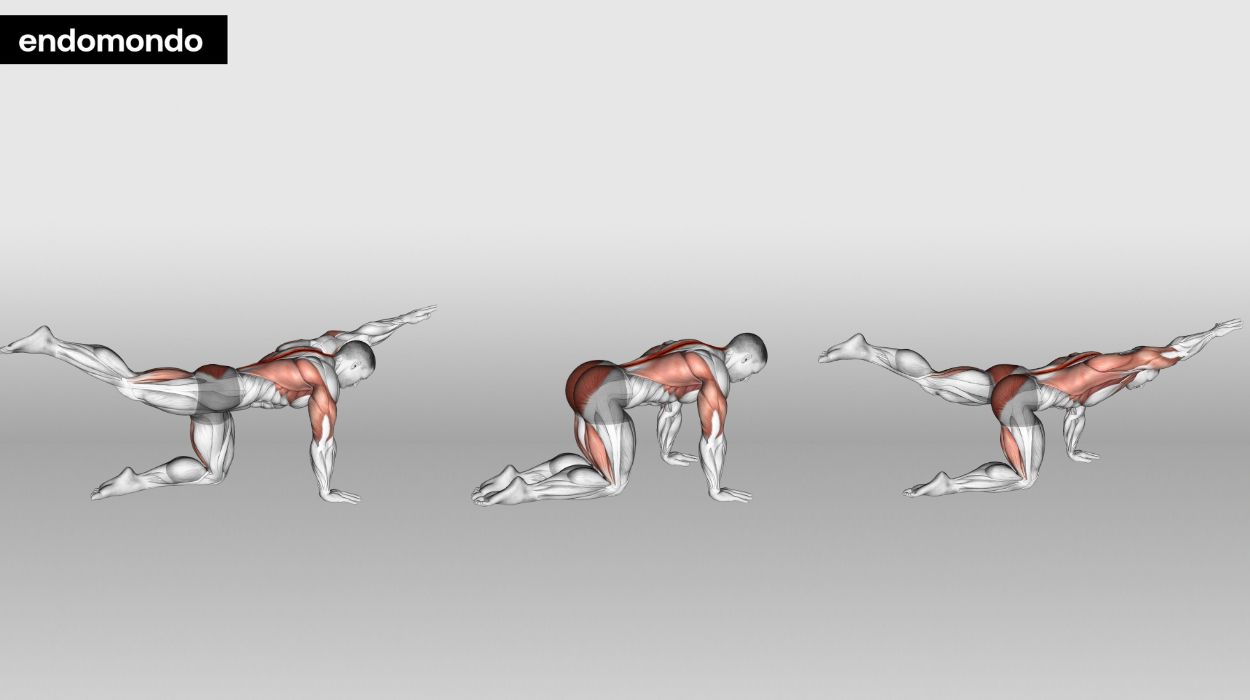
Bird dog is an excellent exercise for core stability and balance.
How to do:
- Start on all fours.
- Position your hands directly under your shoulders and knees under your hips.
- Reach your right arm in front of you while stretching your left leg straight out behind. Keep both parallel to the floor.
- With your core engaged, maintain a straight line from your fingertips to your toes.
- Hold for a moment, then return to the starting position.
- Repeat on the opposite side, alternating between arms and legs.
Tips:
- Breathe rhythmically and exhale as you extend your arm and leg, maintaining proper breathing to support core engagement and stability.
- Focus on a slight tuck of your pelvis and engage your glutes as you lift your leg, helping to stabilize your lower back.
- Incorporate a brief pause at the top of each movement to emphasize balance and control before returning to the starting position.
Optimal Sets and Reps: 2-3 sets of 8-10 reps on each side.
Dead Bug
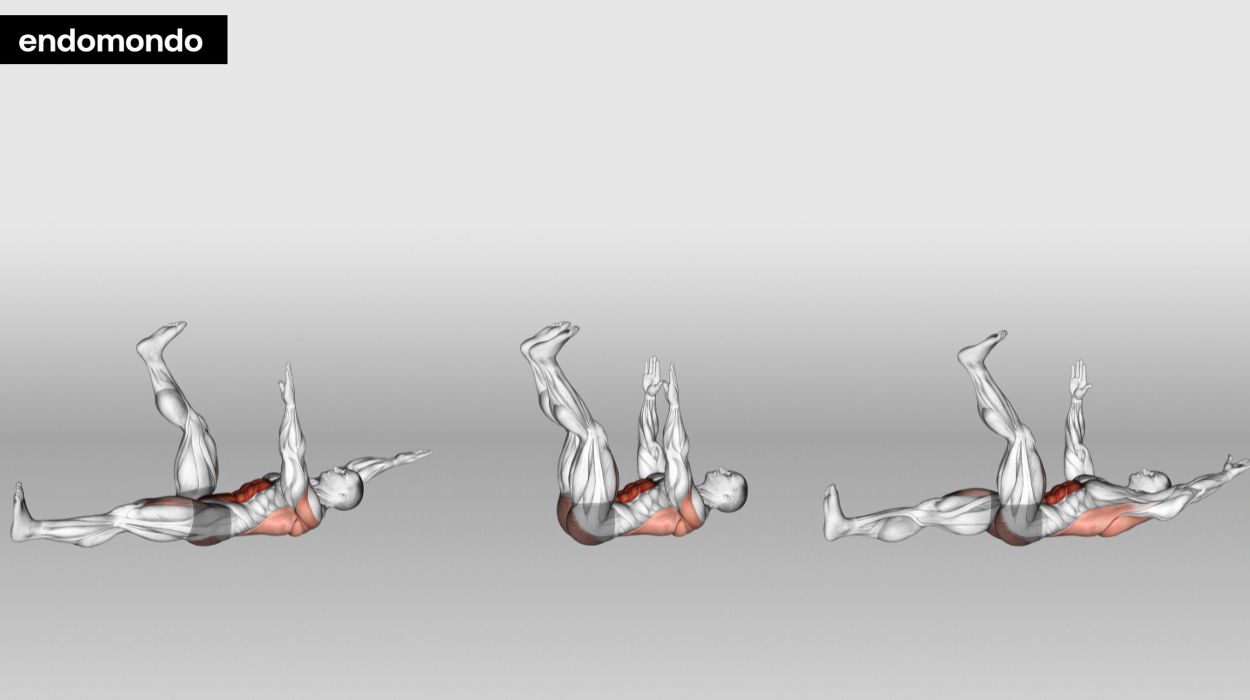
The Dead Bug is a beginner-friendly exercise that strengthens the core and lowers the back.
How to do:
- Lie on your back with your arms extended straight up toward the ceiling.
- Have your knees bent at a 90-degree angle, and keep your shins parallel to the floor.
- Engage your core and slowly lower your right arm and left leg toward the floor.
- Return to the starting position and repeat with the opposite arm and leg.
- Maintain control throughout the movement, keeping your lower back pressed into the floor.
Tips:
- Maintain a neutral neck position by keeping your head relaxed on the ground, reducing any strain on your neck or upper back.
- Focus on breathing steadily throughout the exercise, exhaling as you extend your leg and arm and inhaling as you return to the starting position to support core engagement.
- To increase the challenge and further engage your core, you can add resistance by using a light resistance band placed around your extended foot or hand.
Optimal Sets and Reps: 2-3 sets of 8-10 reps on each side.
Side Plank
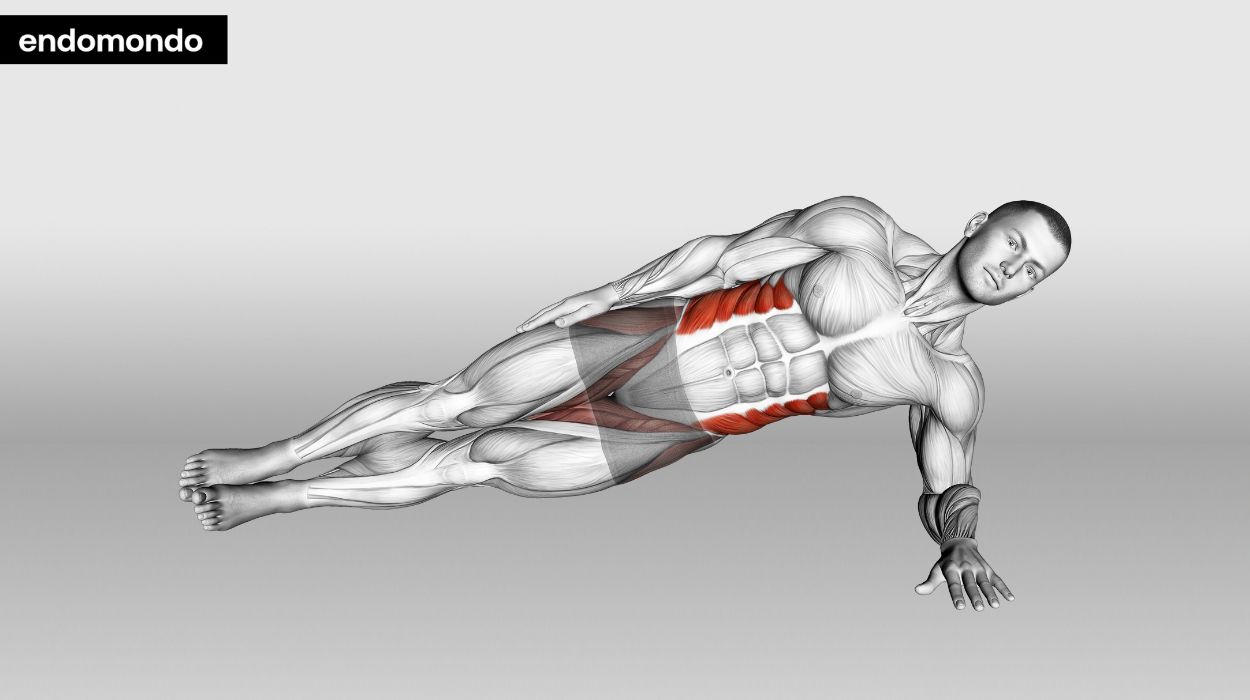
The side plank targets the obliques and deep core muscles.
How to do:
- Lie on your right side with your legs extended and stacked on one another.
- Prop yourself up on your forearm, with your elbow directly under your shoulder.
- Create a straight line from your head to your heels by lifting your hips off the floor.
- Engage your core and hold the position for a set amount of time.
- Repeat on the other side.
Tips:
- Keep your shoulder relaxed and away from your ear to prevent unnecessary tension in your upper body.
- Focus on maintaining steady and controlled breathing throughout the exercise, helping to support core engagement and reduce tension.
- To make the exercise more accessible, you can perform a modified version by keeping your bottom knee on the ground and lifting only your upper body.
Optimal Sets and Reps: 2-3 sets of 15-20 seconds on each side.
Reverse Crunch
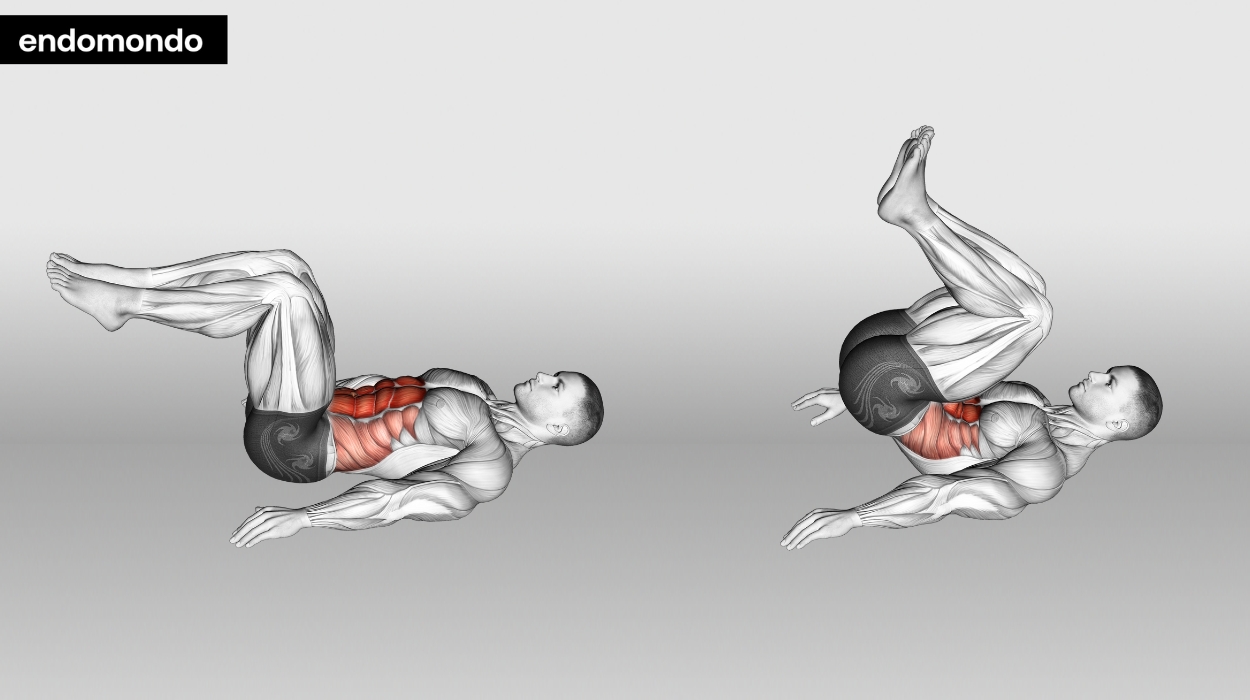
The reverse crunch primarily targets the lower abs but can also engage the hip flexors and obliques.
How to do:
- Lie on your back with feet hip-width apart, flat on the floor, and knees bent.
- Place your arms straight, to the side of your body, palms facing down.
- Engage your core muscles and lift your feet, bringing your knees towards your chest.
- Slowly lower your legs back down, maintaining control throughout the movement.
- Keep your lower back flat against the ground and avoid arching it excessively.
Tips:
- Focus on a controlled movement, avoiding any swinging or using momentum.
- Exhale as you lift your legs, focusing on engaging your lower abs, and inhale as you lower them back down to coordinate your breathing with the movement.
- To increase the challenge and further engage your lower abs, you can add ankle weights or use a stability ball between your ankles.
Optimal Sets and Reps: 2-3 sets of 8-10 reps.
Cat-Cow Pose
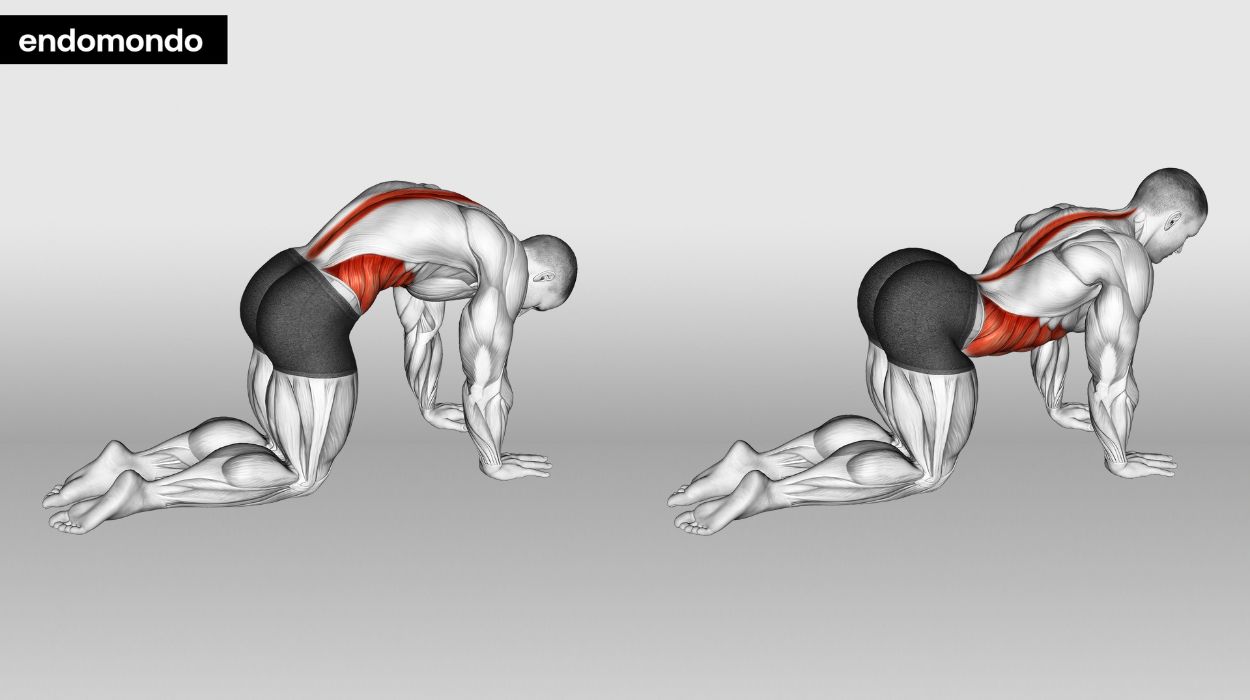
Cat-cow pose, a stomach vacuum exercise, is a yoga exercise for spinal flexibility.
How to do:
- Start on all fours with your hands below your shoulders and knees under your hips.
- Slowly inhale as you drop your belly towards the ground, arching your back and lifting your head.
- Slowly exhale as you round your spine and tuck your chin towards your chest.
- Repeat the fluid motion between the cat and cow positions, focusing on the stretch and activation of the core muscles.
Tips:
- Be sure to focus on controlled movements and avoid excessive strain on the lower back.
- Pay attention to your breath, coordinating each inhale and exhale with the corresponding pose to promote relaxation and release tension in the lower back.
- To enhance the stretch and relieve lower back discomfort further, you can gently sway your hips from side to side while in the Cow Pose position, creating a soothing and mobilizing effect.
Optimal Sets and Reps: 3-5 sets of 5-10 reps.
Glute Bridge
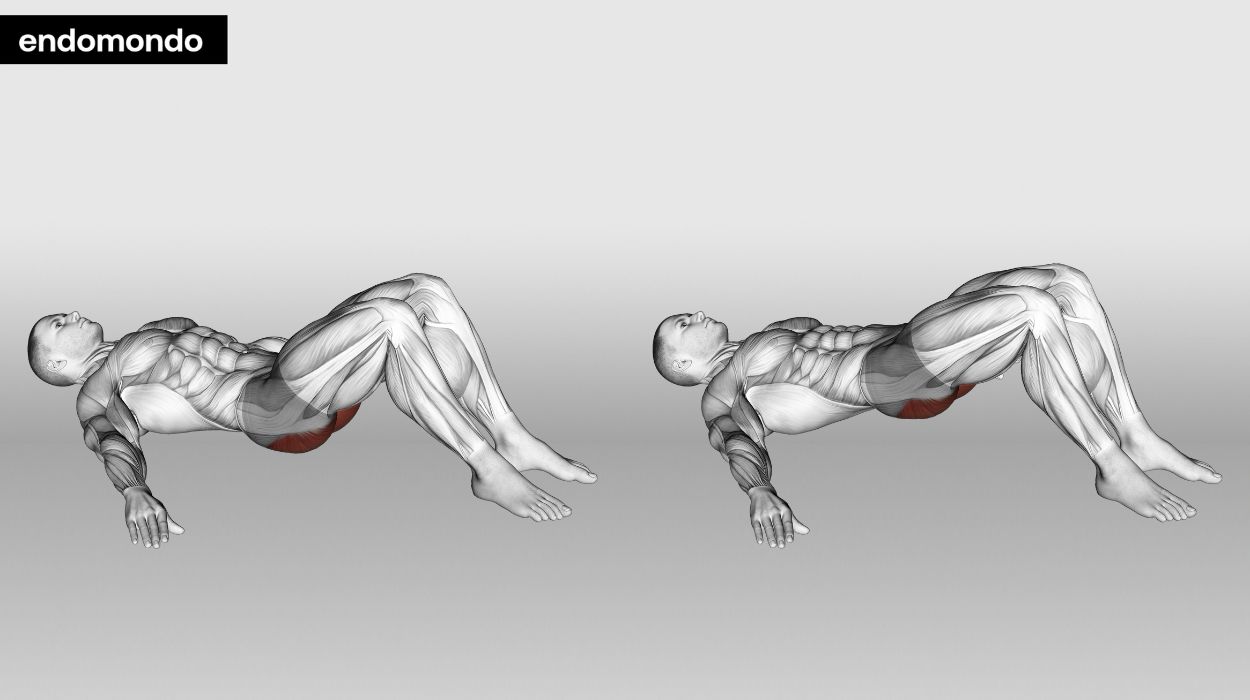
The glute bridge primarily targets the glutes and hamstrings but also engages the core for stability.
How to do:
- Lie on your back with your feet hip-width apart and flat on the ground while your knees are bent.
- Place your arms with palms down by your sides.
- Press through your heels to lift your hips, squeezing your glutes.
- Maintain a straight line from your knees to your shoulders, engaging your core.
- Hold the bridge position for a two-count, then lower your hips.
Tips:
- Ensure your movement originates from the hips and the lower back remains neutral to avoid excessive arching.
- Exhale as you lift your hips off the ground, focusing on engaging your glutes and core, and inhale as you lower them back down to coordinate your breathing with the movement.
- To increase the challenge and further engage your glutes, you can add resistance by placing a small resistance band just above your knees or by lifting one leg at a time while keeping the other knee bent.
Optimal Sets and Reps: 2-3 sets of 10-12 reps.
Full Plank
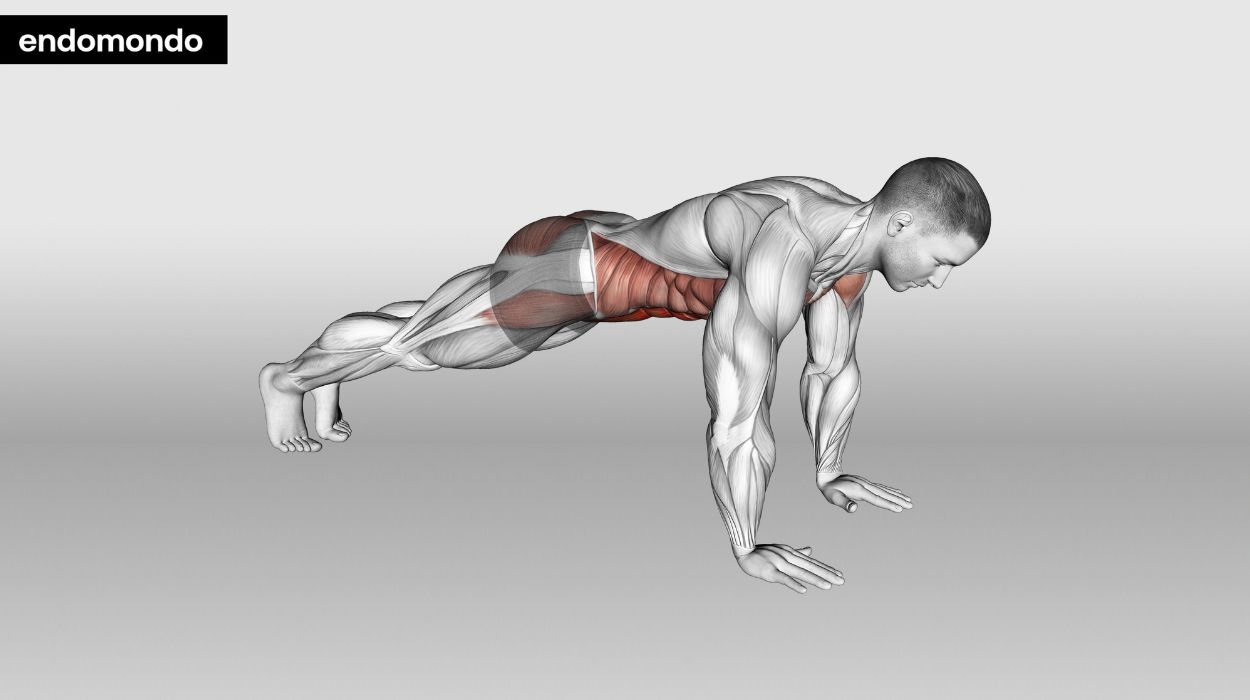
Full plank is a challenging exercise that targets the entire core, including the abdominals, obliques, and deep stabilizing muscles.
How to do:
- Place your palms directly under your shoulders and toes on the ground in a push-up position.
- Keep your body straight from head to heels while engaging the core.
- Make sure your hips are not sagging or raised too high.
- Hold this position for the desired amount of time, typically starting with 20-30 seconds and gradually increasing as you get stronger.
- Remember to breathe.
Tips:
- Keep your head in line with your spine by looking down at the ground, avoiding any strain on your neck or upper back.
- Breathe steadily and rhythmically throughout the exercise, inhaling through your nose and exhaling through your mouth to support core engagement and relaxation.
- To modify the exercise and make it more accessible, you can perform a forearm plank by resting on your forearms instead of your hands.
Optimal Sets and Reps: 2-3 sets of 10-20 seconds.
Bicycle Crunch
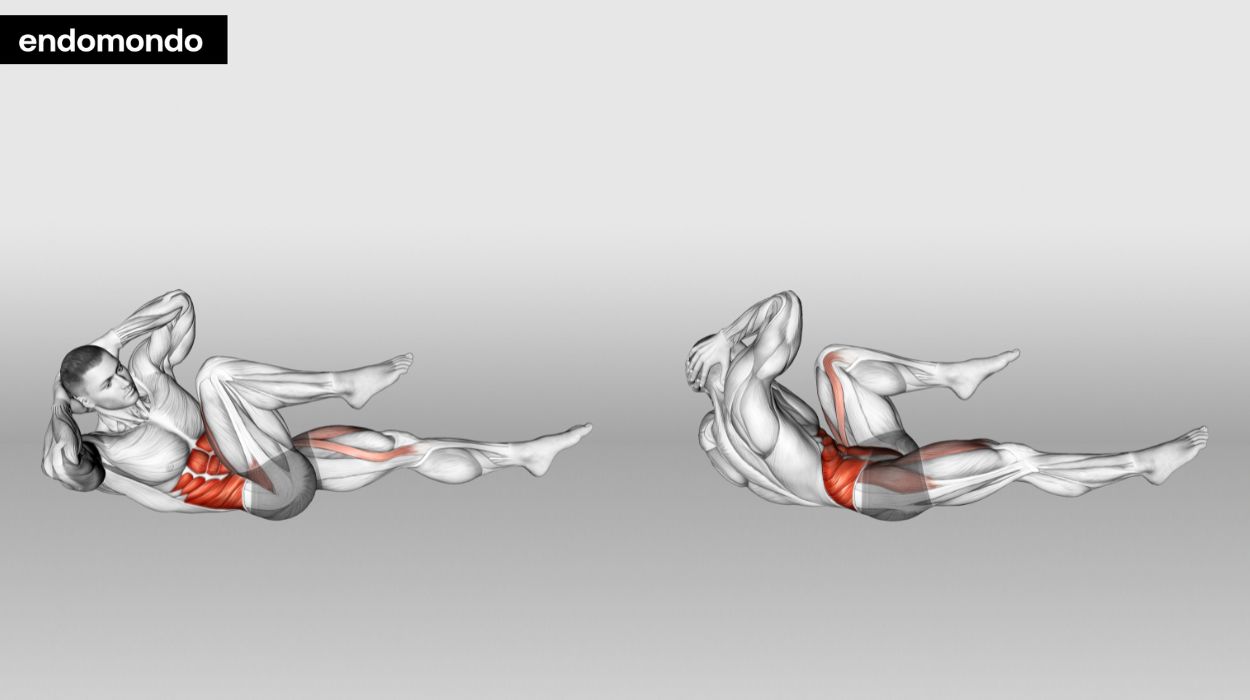
The bicycle crunch targets the rectus abdominis, obliques, and hip flexors.
How to do:
- Lie on your back, your feet flat on the floor, and your knees bent.
- Place your hands gently behind your head.
- Lift your head and shoulders slightly off the ground.
- Instead of extending your legs fully, keep them bent at a 45-degree angle.
- Alternate bringing your right elbow towards your left knee and left elbow towards your right knee in a controlled and smooth motion.
- Focus on engaging your core muscles and avoid straining your lower back.
Tips:
- Avoid pulling on your neck throughout the exercise and maintain a neutral spine.
- To reduce strain on your neck and upper back, place your hands lightly behind your ears without pulling on your head, allowing your core to do the work.
- Since it puts some pressure on the lower back, pay attention to any pain and switch to another exercise if needed.
Optimal Sets and Reps: 2-3 sets of 10-12 reps on each side.
Lying Windshield Wipers
Lying windshield wipers is an advanced exercise that targets the obliques and core.
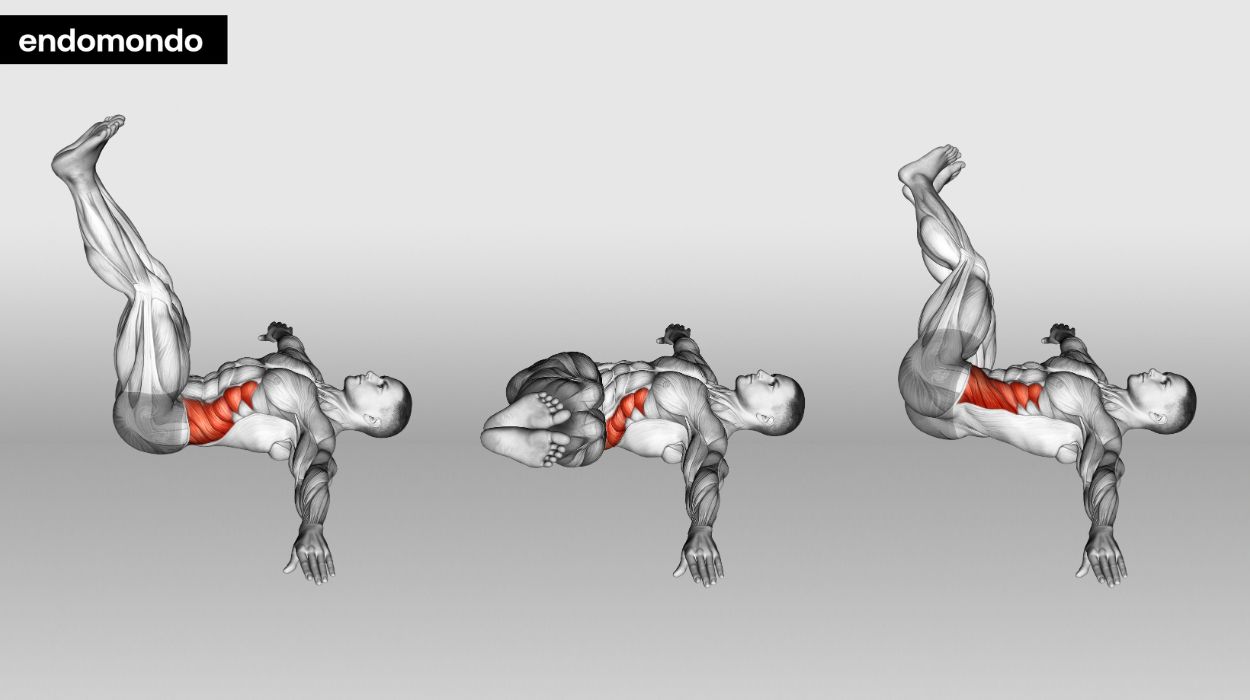
How to do:
- Lie flat on your back.
- Stretch your arms to the sides to form a “T” shape.
- Lift your feet off the ground and bend your knees at a 90-degree angle.
- Keeping your core engaged, slowly lower your legs to one side, trying to touch the floor with your knees without letting them rest on the ground.
- Return to the starting position.
- Repeat the movement to the other side.
Tips:
- Ensure that your lower back is adequately supported throughout the movement, you can place a small rolled-up towel or cushion under your lower back to provide additional support.
- Prioritize proper pre-workout warm-up and stretching before attempting this exercise to prepare your muscles and reduce the risk of strain.
- Focus on your body’s feedback – if you feel any discomfort or strain, modify the range of motion or choose a different exercise that is more suitable for your condition.
Optimal Sets and Reps: 2-3 sets of 10-12 reps per side.
Can Ab Workouts Cause Back Pain?

According to a 2016 study,[1] 60%-80% of adults in Western countries experience lower back pain. It’s considered one of the most common musculoskeletal problems globally, causing inactivity and missed work.
Lower back pain can be broken into three categories:[1]
- Acute — short-term pain lasting less than six weeks.
- Sub-acute — pain that persists between six weeks to three months.
- Chronic — pain that lasts longer than three months and can be debilitating.
For some, starting a new workout routine can cause acute back pain. However, studies show[2] that physical activity can help improve many types of lower back pain. So if you want to start exercising, remember to carefully choose suitable ab workouts with lower back pain for your workout plan.
Benefits Of Core Exercise
Here are four reasons to focus on core exercises for back pain:
- Increases core muscle strength — especially trunk muscles that tend to weaken as we age. A 2017 study suggests deficiencies in these muscles increase lower back pain, so an effective core workout is essential.
- Increases core stability — can help stabilize the spine and maintain an upright proper body position. This study suggests major stability improvements[3] and daily functions could happen in as little as four weeks of training.
- Helps with balance — which is essential for daily activities like standing, walking while talking, and changing directions. According to a 2021 literature review, improved balance can help foster independence and improve the quality of life for older adults.
- Supports better posture — poor posture increases the risk[4] of musculoskeletal problems and lower back pain. Therefore, functional core exercises and some yoga practices can help.
How To Protect Lower Back When Doing Ab Workouts
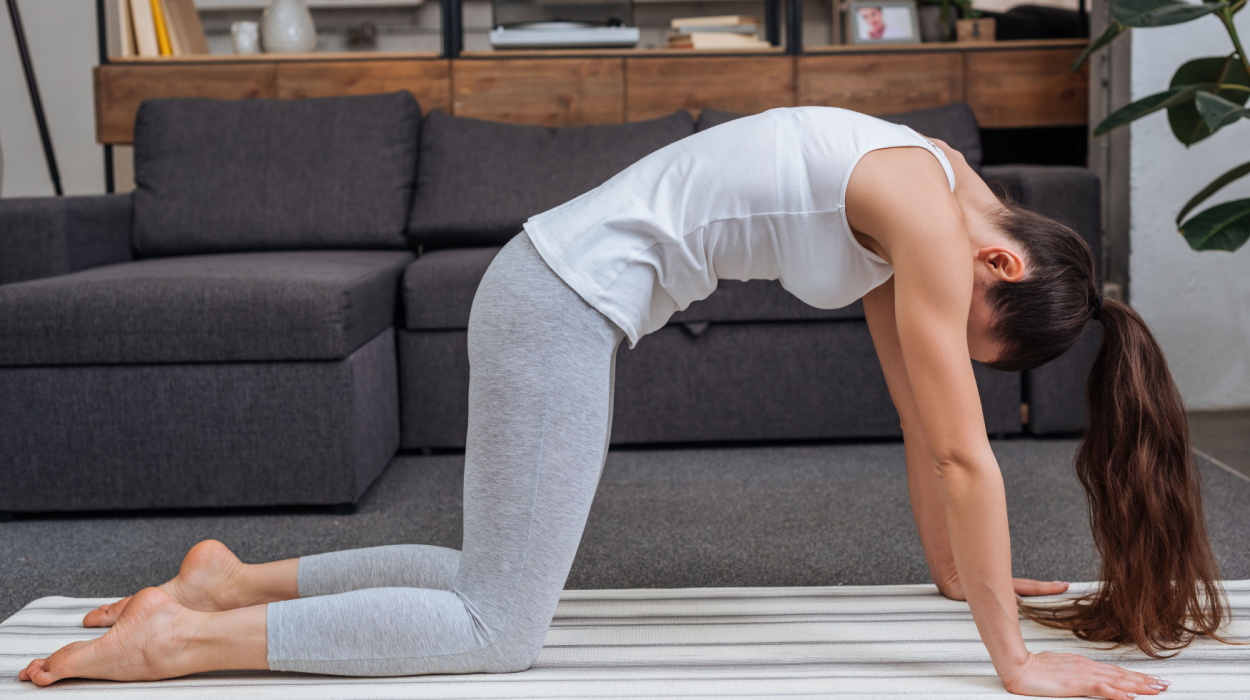
The most common reason[5] for lower back pain with ab exercises is due to poor form. To protect your lower back, consider these tips:
- Maintain proper form: Maintain a neutral spine alignment throughout each exercise. Avoid excessive arching or rounding of the back, which can strain the lower back.
- Engage your core: Core muscles can help distribute the load evenly and reduce stress on the lower back.
- Gradually increase intensity: Slowly increase the difficulty of your ab workouts as your core strength improves to lower your risk of lower back pain.
- Use modifications: Modify exercises to suit your comfort level and lower back condition.
- Listen to your body: Watch for any discomfort or pain during ab exercises. Then, modify or consult with a healthcare professional if needed.
- Seek professional guidance: If you have chronic lower back pain or specific concerns, consider a physical therapist or fitness professional for personalized exercises tailored to your needs.
The Bottom Line
Incorporating exercise for abs into your fitness routine can not only effectively strengthen your core and enhance overall stability, but it may also help you lose weight. Combining regular exercise with a healthy diet for weight loss and a toned midsection is crucial.
Also, consider adding a complete vitamin or fat-burning supplement for extra support. With consistency, smart choices, and a balanced approach, you can achieve a stronger core and work towards a healthier, pain-free lifestyle.
Frequently Asked Questions
Yes, doing ab workouts with lower back pain is generally considered beneficial. Strengthening your currently weak core muscles can better support your spine, improve balance, and promote proper posture. These benefits may help alleviate lower back pain and improve overall stability.
When dealing with lower back problems, avoid exercises that can strain the lower back, like heavy lifting, high-impact, or excessive twisting or bending.
Generally, strengthening the abdominal muscles can help relieve lower back pain. However, squats can sometimes add strain to the muscles of the lower back. Be sure to maintain proper form to help minimize lower back stress.
Individuals with chronic lower back pain, herniated discs, or other pre-existing lower back conditions should consult a healthcare professional or physical therapist before starting a new workout routine.
Resources
- Gordon, R. and Cotton, D. (2016). A Systematic Review of the Effects of Exercise and Physical Activity on Non-Specific Chronic Low Back Pain. Healthcare, [online] 4(2), pp.22–22. doi:https://doi.org/10.3390/healthcare4020022.
- Coulombe, B.J., Games, K.E., Neil, E.R. and Eberman, L.E. (2017). Core Stability Exercise Versus General Exercise for Chronic Low Back Pain. Journal of Athletic Training, [online] 52(1), pp.71–72. doi:https://doi.org/10.4085/1062-6050-51.11.16.
- Chumpitazi, B.P., Lim, J.-H., McMeans, A.R., Shulman, R.J. and Hamaker, B.R. (2018). Evaluation of FODMAP Carbohydrates Content in Selected Foods in the United States. The Journal of Pediatrics, [online] 199, pp.252–255. doi:https://doi.org/10.1016/j.jpeds.2018.03.038.
- Rathore, M., Trivedi, S., Abraham, J. and Sinha, M.S. (2017). Anatomical correlation of core muscle activation in different yogic postures. International Journal of Yoga, [online] 10(2), pp.59–59. doi:https://doi.org/10.4103/0973-6131.205515.
- Fares, M.Y., Fares, J., Salhab, H.A., Khachfe, H.H., Bdeir, A. and Fares, Y. (2020). Low Back Pain Among Weightlifting Adolescents and Young Adults. Cureus. [online] doi:https://doi.org/10.7759/cureus.9127.




